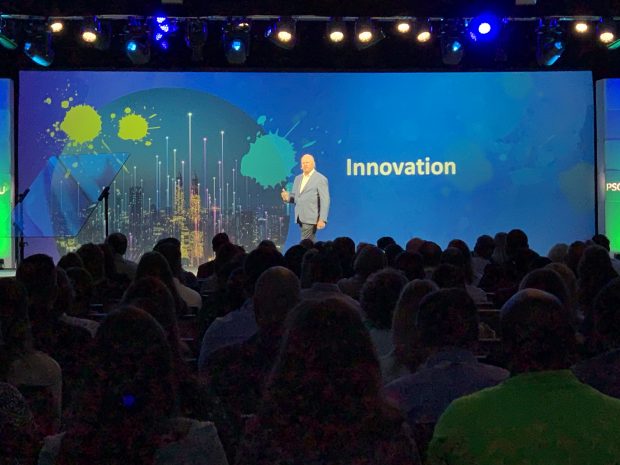 PSCU's President/CEO Chuck Fagan speaks during the organization's Member Forum in Tampa, Fla.
PSCU's President/CEO Chuck Fagan speaks during the organization's Member Forum in Tampa, Fla.
Eight years into his second time leading PSCU, Chuck Fagan appears to have a better and bigger picture of the credit union payments industry, especially in this post-COVID reality. "I think what COVID did was drive things more toward a personalized member experience," Fagan said.
He sat down for an interview Tuesday with CU Times during PSCU's Member Forum in Tampa, Fla., to discuss payment trends, the economy and specific concerns about how some financial institutions are using Buy Now, Pay Later (BNPL) products.
Recommended For You
CU Times: What's your focus right now as PSCU's leader?
Fagan: I think the one thing I concentrate most on is making sure that our company, regardless of the area that we're in, we're at least as fast as our credit unions. I think it's just critically important for credit unions to stay as current as possible. I don't think bleeding edge is necessary, but I do think leading edge is necessary. You can't, you can't lag behind it. One of the things that I like to do within PSCU is work with our CFO to ensure that we have a discipline in place of investing at least, or a minimum of, 5% of our revenues back into capital on an annual basis. That number's been over 7% more recently. And that means a little over $60 million that we're investing back in technology and things to keep our credit unions current.
CU Times: What's your reasoning behind that level of investment?
Fagan: The reason I go down that path is because the 16- to 25-year-olds, they don't have the same loyalty that I had when I started in 1988 at Virginia Credit Union. I still have that same account that I opened in 1988. The loyalty that exists from that segment, 16 or so to 25, they grew up with a loyalty to Facebook, Instagram, Google. And all of those fintechs are trying to be in the payment space as well. So if our credit unions don't have what that segment is looking for, their loyalty is to move elsewhere fast. So that's why I think speed is so important.
 Chuck Fagan
Chuck Fagan CU Times: There's been a lot of discussion here about the acceleration of advancements in the payments space.
Fagan: COVID was the great accelerator. If it did anything, it pushed people to adopt digital.
CU Times: Can you explain that?
Fagan: So I believe that payments are what defines that ultimate primary financial institution relationship. So if you consider direct deposit as a payment. If you consider your mortgage payment. If you consider your daily use of a debit card, accessing your account, your use of a credit card, depending on how you spend – that definition and reality … that's the primary financial institution relationship. So I think given that as a stated thing and when you think about the time period that we dealt with COVID, the consumer connects differently than they used to. I won't go so far as to say that a branch is an expensive billboard, but the branch has changed in that it's more about life changing events.
CU Times: During your speech you mentioned the economic risks ahead. Would you add the explosion of Buy Now, Pay Later to that list of economic risks?
Fagan: It's absolutely something we need to watch, especially right now with inflation and with a looming potential of a light recession.
The risk around Buy Now, Pay Later is 'stacking.' You're not doing a credit check, so you're not understanding what level of debt the consumer may have. And when they go to purchase something at one merchant and then they go to purchase at another and another, they begin stacking these Buy Now, Pay Laters, usually over four installment payments. And you're going to see delinquency on Buy Now, Pay Later. And I think ultimately the federal government will try and put some rules and regulations around that. We don't have them yet, but to your point, I do think it's absolutely something we need to watch.
We tried to build ours in a way that respects budgeting and respects financial wellness. So ours utilizes the existing credit line from the credit card account. And ours is post-transaction, so the consumer can decide, 'Hey, I want to pay for this transaction with a portion of my reward points and I want to pay the rest on a Buy Now, Pay Later setup.' So, it's a little bit different in the way that we've done it.
© Touchpoint Markets, All Rights Reserved. Request academic re-use from www.copyright.com. All other uses, submit a request to [email protected]. For more inforrmation visit Asset & Logo Licensing.







